The Processed Beef Market is estimated to be valued at USD 158.5 billion in 2025 and is projected to reach USD 375.2 billion by 2035, registering a compound annual growth rate (CAGR) of 9.0% over the forecast period.
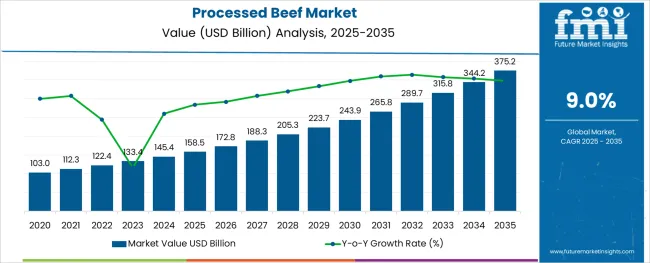
The processed beef market is witnessing stable growth as changing dietary patterns, rising urbanization, and advancements in cold chain logistics continue to shape consumption trends. Increased demand for protein-rich diets combined with convenience-driven lifestyles has fueled the adoption of processed beef products across retail and foodservice channels.
The market is being influenced by investments in automation, improved shelf-life technologies, and expansion of organized retail formats that promote accessibility and affordability. In the future, rising awareness about quality standards, stringent food safety regulations, and the incorporation of value-added flavors and formats are expected to drive further growth.
Opportunities are emerging in premiumization, sustainable packaging, and the development of healthier formulations that cater to evolving consumer expectations. These factors collectively are paving the path for sustained demand and greater penetration of processed beef offerings globally.
The market is segmented by Form, Nature, Buyer Type, and Sales Channel and region. By Form, the market is divided into Frozen, Chilled, and Shelf Stable. In terms of Nature, the market is classified into Conventional and Organic. Based on Buyer Type, the market is segmented into Food Processor & Manufacturers, HoReCa Sector, and Household and Residential Buyers.
By Sales Channel, the market is divided into Supermarket/Hypermarket, Traditional Grocery Stores, Internet Retailing, Convenience Store, Discounters, and Other Sales Channel. Regionally, the market is classified into North America, Latin America, Western Europe, Eastern Europe, Balkan & Baltic Countries, Russia & Belarus, Central Asia, East Asia, South Asia & Pacific, and the Middle East & Africa.
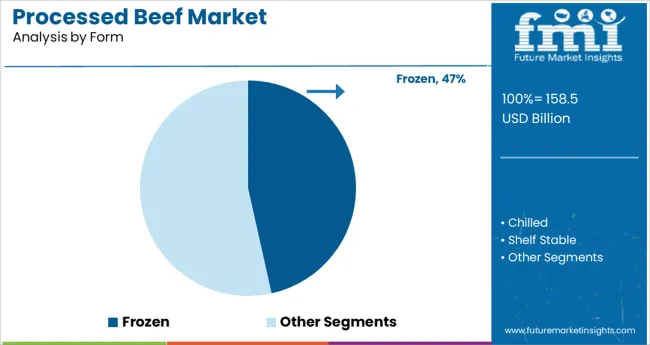
When segmented by form, the frozen segment is anticipated to hold 46.5% of the total market revenue in 2025, establishing itself as the leading form category. This leadership has been supported by the superior shelf-life and logistical advantages offered by frozen products, which enable wider geographic distribution without compromising quality.
Advancements in freezing technologies and packaging have improved product integrity, meeting both regulatory standards and consumer expectations for safety and freshness. The ability to stockpile inventory and reduce waste has been appealing to retailers and foodservice operators, fostering increased adoption.
As consumer preferences shift toward convenient meal solutions, frozen processed beef has gained prominence as it allows for flexible consumption while maintaining nutritional value and taste. These attributes have collectively reinforced the dominant position of the frozen segment within the form category.
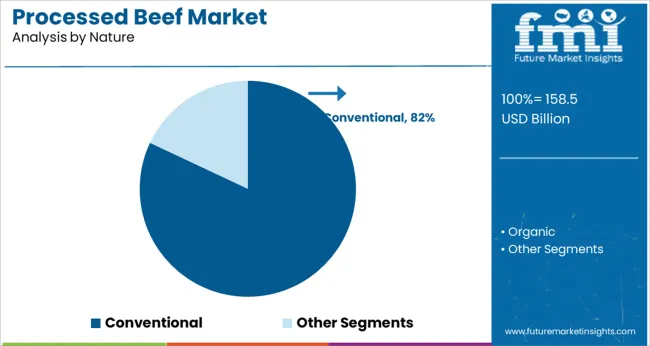
Segmenting by nature reveals that the conventional segment is expected to account for 82.0% of the market revenue in 2025, securing its position as the leading category. This dominance has been driven by its affordability, established supply chains, and widespread acceptance among price-sensitive consumers.
Conventional production methods have enabled high-volume output at competitive prices, making them accessible to a broader demographic. Manufacturers have continued to focus on efficiency and consistency in conventional offerings, meeting the expectations of institutional buyers and retail consumers alike.
Limited awareness and relatively higher costs associated with alternative or premium variants have further cemented the conventional segment’s leadership. Its scalability, combined with robust distribution networks and familiarity among end-users, has contributed to its sustained prominence in the processed beef market.
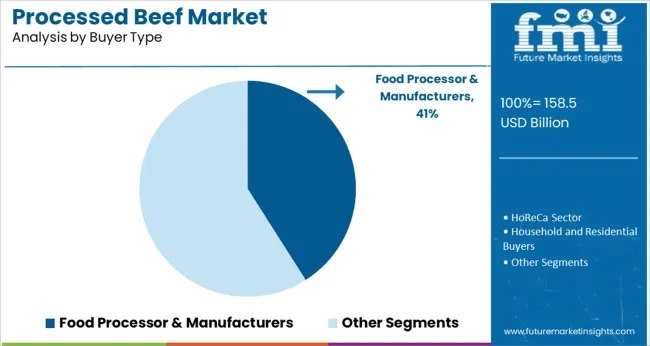
When segmented by buyer type, food processors and manufacturers are projected to capture 41.0% of the total market revenue in 2025, positioning them as the leading buyer group. This segment’s prominence has been reinforced by their role in incorporating processed beef into a variety of ready-to-eat and ready-to-cook products catering to retail and foodservice markets.
The ability of processors and manufacturers to leverage economies of scale, ensure consistent quality, and innovate with product formats has fueled their demand for processed beef. Their strategic focus on developing differentiated offerings for diverse consumer segments has made them significant contributors to overall market growth.
Additionally, the integration of advanced processing technologies and strong supplier relationships have enhanced efficiency and reliability, strengthening the position of food processors and manufacturers as the dominant buyer type in this market.
Driven by the growth of the food industry across the globe, the processed beef market is anticipated to rise at 9% CAGR from 2025 to 2035 in comparison to the 7.9% CAGR registered from 2020 to 2025.
FMI provides a half-yearly comparison study and evaluation of the worldwide market's growth rates as well as its future development potential. Some demographic and innovation aspects of the market are dominated by the subjective effect of macro and industry variables.
The necessity for animal-based protein and the overall rise in health consciousness are two major factors affecting the sector. As a result of shifting dietary habits, consumer preferences for foods with low calorie and fat content and high protein value are rapidly evolving.
Additionally, the food industry is using beef more frequently, which is contributing to market growth. Burgers, sausages, and steaks made of beef are regularly offered to clients at cafés and restaurants to serve them authentic and multi-cuisine dishes.
The first quarter of 2024 saw an increase of 7.5% in the worldwide market for processed beef. However, the distribution of this increase is uneven, with developing countries experiencing greater growth rates of 8.4%.
In the second half of the projection period, numerous other market segments are anticipated to perform reasonably and achieve attractive development possibilities.
Despite these promising developments, the business is still expected to face significant obstacles, such as shifting customer tastes, strict trade restrictions, and a lack of security in the supply of raw materials and other production inputs.
| Historical CAGR (2020 to 2025) | 7.9% |
|---|---|
| Historical Market Value (2025) | USD 122.1 Billion |
| Forecast CAGR (2025 to 2035) | 9% |
Will Innovations Remain Chief Processed Beef Market Driver?
The success of marketing meat depends on innovation and consistent production of high-quality processed food products. The frozen processed meat trend is one of the key reasons behind the growth of the production and sales of processed beef. Additionally, the rise of internet retailing is boosting the sales of processed food as well as processed meat.
Increasing consumer knowledge about the benefits of processed beef products is driving sales among household and residential purchasers. Processed beef is preferred by household buyers because it has a superior taste, flavor, appearance, and shelf life than unprocessed beef.
With the shifting taste palates and openness to try new goods, consumers in developed regions such as North America and Europe have begun to choose freshly processed meat products, particularly processed beef.
Consumers who are health and sustainability-conscious prefer natural, organic, and nutritional products, which is why the sale of organic meat or organic beef more specifically is fast expanding.
The trend of frozen foods has taken off owing to the new-age consumers’ desire for food traceability. With the convenience element linked with frozen food, consumers in various regions are expected to invest heavily in its purchase. Rapid developments in freezing procedures to increase the shelf life of processed beef products without sacrificing quality are driving frozen beef sales in the processed beef sector.
To stimulate the adoption of frozen beef and chilled beef or chilled meat products, manufacturers in the processed beef market are expected to offer fascinating innovations in terms of look, taste, packaging, and tastes, based on these rising consumer demands.
With the rise of fast food, food items like meat patty made of ground beef are in high demand. However, the trend of meat extenders may impact the processed beef market negatively.
According to FMI, sales of chilled processed beef are anticipated to grow at a CAGR of 8.4% over the forecast period, owing to increasing demand for extended shelf-life meat products. The storage life of chilled meat can be extended by packaging the product with N2 or CO2.
In 2025, conventional processed beef accounted for approximately 85.4% of the global market, while the demand for organic processed beef is expected to rise at a CAGR of 9.2% during the forecast period.
Based on buyer type, the household and residential buyer segments are estimated to account for a market share of 57.5% in 2025. A high preference for convenient breakfast food items will spur growth in this category with a CAGR of 8.1% growth.
Supermarkets/hypermarkets accounted for 44.6% of sales in 2025. They are expected to continue dominating the market based on the sales channel. The ability to check and select their products in real-time draws meat buyers towards supermarkets/hypermarkets.
| Segment | Top Buyer Type |
|---|---|
| Attributes | Household and Residential Buyers |
| Historical CAGR | 7.3% |
| Forecasted CAGR | 8.1% |
| Segment | Top Form |
|---|---|
| Attributes | Chilled |
| Historical CAGR | 7.6% |
| Forecasted CAGR | 8.4% |
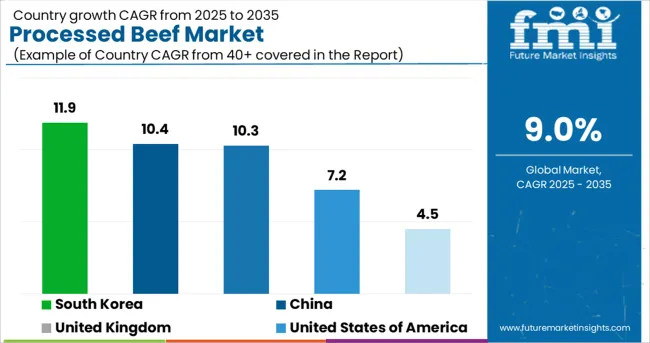
| Region | North America |
|---|---|
| Country | United States of America |
| Historical CAGR | 6.7% |
| CAGR | 7.2% |
| Market Value (2025) | USD 35.1 Billion |
| Market Value (2035) | USD 69.7 Billion |
| Region | Europe |
|---|---|
| Country | United Kingdom |
| Historical CAGR | 10.8% |
| CAGR | 10.3% |
| Market Value (2025) | USD 6.3 Billion |
| Market Value (2035) | USD 10 Billion |
| Region | Asia Pacific |
|---|---|
| Country | China |
| Historical CAGR | 9.9% |
| CAGR | 10.4% |
| Market Value (2025) | USD 30.6 Billion |
| Market Value (2035) | USD 19.2 Billion |
| Region | Asia Pacific |
|---|---|
| Country | Japan |
| Historical CAGR | 4.1% |
| CAGR | 4.5% |
| Market Value (2025) | USD 1.3 Billion |
| Market Value (2035) | USD 3.6 Billion |
| Region | Asia Pacific |
|---|---|
| Country | South Korea |
| Historical CAGR | 9.7% |
| CAGR | 11.9% |
| Market Value (2025) | USD 13.2 Billion |
| Market Value (2035) | USD 3.6 Billion |
The Europe market is expected to register impressive growth at a CAGR of 8.8% over the forecast period, owing to increasing demand for processed meat products. It is expected that sausages and salami will continue to be highly popular processes used in European countries like Italy and the United Kingdom to manufacture processed beef. The EU-4 processed beef market is dominating Europe with a market share of more than 50% in 2025.
Russian consumers are expected to demand organic processed beef throughout the forecast period.
United Kingdom Accounts for Substantial Processed Meat Demand
Over the next few years, the demand for convenience foods in the UK is expected to increase. This is due to a high migrant population and the growing consumption of convenience foods. Millennials' increasing desire for snacking and immediate consumption is also predicted to drive market growth in the country.
In 2025, the China-processed beef market is estimated to account for more than 54.6% of sales in Asia Pacific. According to FMI, the consumption of processed beef in India is expected to showcase a higher rate of growth at a CAGR of 12.7% over the forecast period.
Consumers' hurried and chaotic lifestyles have come from China's growing urbanization and industrialization. This fast-paced lifestyle has resulted in new eating patterns that deviate from the traditional three-square-meal dinner table. Subsequently, the demand for convenience food is on the rise, which has resulted in high sales of processed beef in China.
South Korea held a share of 30.0% in the Asia Pacific market. According to FMI, the demand for processed beef in South Korea is expected to grow at a CAGR of 11.9% over the forecast period.
As packaged processed beef products are sold by well-established corporations like the WH Group Godrej Tyson Foods Ltd in most countries in the Asia Pacific, they are deemed hygienic and of good quality. This will remain one of the chief factors driving sales of processed beef in South Korea.
According to FMI, the sales of processed beef in GCC Countries are estimated to account for 30.3% of the overall Middle East and Africa market. Processed beef with claims like halal and Kosher is gaining traction among consumers in the Middle East and Africa. This also is expected to remain a chief growth driver of the market in GCC countries.
Processed beef manufacturers are focusing on developing novel and unique items that will appeal to consumers. They are introducing a variety of processed beef products with distinct aromas, shapes, flavors, and nutritional benefits. The global demand for chilled and frozen processed beef is growing. Modern trade and internet selling are boosting the availability of processed beef products.
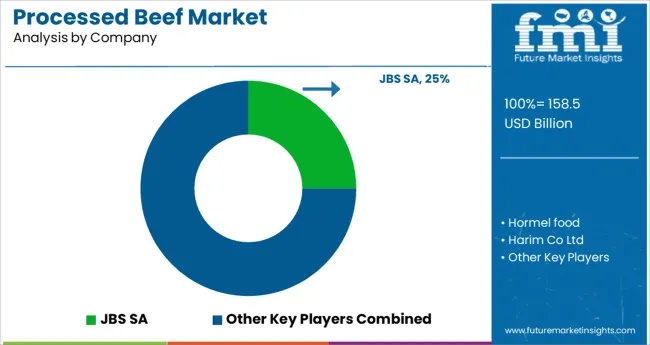
Some of the prominent players in the Processed Beef market are as follows:
Recent Development:
Companies operating in the processed beef market are aiming for expansions and strategic partnerships with other manufacturers to expand their product manufacturing capabilities, portfolios, and global presence. In the processed beef market, top competitors are introducing the latest technologies to enhance the shelf life, texture, and flavor of processed beef. Besides this, some firms are expanding their footprint into emerging nations to gain a competitive edge.
| Attribute | Details |
|---|---|
| Forecast Period | 2025 to 2035 |
| Historical Data Available for | 2020 to 2024 |
| Market Analysis | million for Value and MT for Volume |
| Key Regions Covered | North America; Latin America; Europe; The Middle East and Africa; East Asia |
| Key Countries Covered | USA, Canada, Brazil, Mexico, Chile, Peru, Germany, UK, Spain, Italy, France, Russia, Poland, China, India, Japan, Australia, New Zealand, GCC Countries, North Africa, South Africa, and Turkey |
| Key Segments Covered | Form, Nature, Buyer Type, Sales Channel, Region |
| Key Companies Profiled | JBS SA,; Hormel food; Harim Co Ltd; Tyson Foods Inc.; Danish Crown A/S; Cargill Meat Solution Corp.; WH Group; BRF SA; Smithfield Foods, Inc.; SYSCO Corp; Others |
| Report Coverage | Market Forecast, Company Share Analysis, Competition Intelligence, Drivers, Restraints, Opportunities and Threats Analysis, Market Dynamics and Challenges, and Strategic Growth Initiatives |
| Customization & Pricing | Available upon Request |
The global processed beef market is estimated to be valued at USD 158.5 billion in 2025.
It is projected to reach USD 375.2 billion by 2035.
The market is expected to grow at a 9.0% CAGR between 2025 and 2035.
The key product types are frozen, chilled and shelf stable.
conventional segment is expected to dominate with a 82.0% industry share in 2025.






Our Research Products

The "Full Research Suite" delivers actionable market intel, deep dives on markets or technologies, so clients act faster, cut risk, and unlock growth.

The Leaderboard benchmarks and ranks top vendors, classifying them as Established Leaders, Leading Challengers, or Disruptors & Challengers.

Locates where complements amplify value and substitutes erode it, forecasting net impact by horizon

We deliver granular, decision-grade intel: market sizing, 5-year forecasts, pricing, adoption, usage, revenue, and operational KPIs—plus competitor tracking, regulation, and value chains—across 60 countries broadly.

Spot the shifts before they hit your P&L. We track inflection points, adoption curves, pricing moves, and ecosystem plays to show where demand is heading, why it is changing, and what to do next across high-growth markets and disruptive tech

Real-time reads of user behavior. We track shifting priorities, perceptions of today’s and next-gen services, and provider experience, then pace how fast tech moves from trial to adoption, blending buyer, consumer, and channel inputs with social signals (#WhySwitch, #UX).

Partner with our analyst team to build a custom report designed around your business priorities. From analysing market trends to assessing competitors or crafting bespoke datasets, we tailor insights to your needs.
Supplier Intelligence
Discovery & Profiling
Capacity & Footprint
Performance & Risk
Compliance & Governance
Commercial Readiness
Who Supplies Whom
Scorecards & Shortlists
Playbooks & Docs
Category Intelligence
Definition & Scope
Demand & Use Cases
Cost Drivers
Market Structure
Supply Chain Map
Trade & Policy
Operating Norms
Deliverables
Buyer Intelligence
Account Basics
Spend & Scope
Procurement Model
Vendor Requirements
Terms & Policies
Entry Strategy
Pain Points & Triggers
Outputs
Pricing Analysis
Benchmarks
Trends
Should-Cost
Indexation
Landed Cost
Commercial Terms
Deliverables
Brand Analysis
Positioning & Value Prop
Share & Presence
Customer Evidence
Go-to-Market
Digital & Reputation
Compliance & Trust
KPIs & Gaps
Outputs
Full Research Suite comprises of:
Market outlook & trends analysis
Interviews & case studies
Strategic recommendations
Vendor profiles & capabilities analysis
5-year forecasts
8 regions and 60+ country-level data splits
Market segment data splits
12 months of continuous data updates
DELIVERED AS:
PDF EXCEL ONLINE
Competitive Breakdown of Processed Beef Market Share
UK Processed Beef Market Size and Share Forecast Outlook 2025 to 2035
Analysis of the USA Processed Beef Market by Product Type, Processing Method, Distribution Channel, Packaging Type and Region through 2035
Analysis of the Europe Processed Beef Market by Product Type, Processing Method, Distribution Channel, Packaging Type and Region through 2035
Asia Pacific Processed Beef Market Outlook - Size, Share & Industry Trends 2025 to 2035
Beef Grower Market Analysis - Size, Share, and Forecast Outlook 2025 to 2035
Beef Fat Market Size and Share Forecast Outlook 2025 to 2035
Processed Fruit and Vegetable Market Analysis - Size, Share, and Forecast Outlook 2025 to 2035
Beef Concentrate Market Size, Growth, and Forecast for 2025 to 2035
Market Share Insights for Processed Cashew Providers
Analysis and Growth Projections for Processed Superfruit Market
Processed Meat Market Analysis by Type, Packaging, Meat Type, and Region through 2035
Beef Flavors Market Insights - Trends & Forecast 2025 to 2035
Analysis and Growth Projections for Processed Cheese Market
Processed Cashew Market Trends – Snack Innovation & Industry Growth 2025 to 2035
Processed Meat Packaging Market Growth & Trends 2024 to 2034
Beef Bouillon Market
Processed Eucheuma Seaweed Market
Reprocessed Medical Devices Market Size and Share Forecast Outlook 2025 to 2035
Brief Outlook of Growth Drivers Impacting Consumption of UK Processed Cashew.

Thank you!
You will receive an email from our Business Development Manager. Please be sure to check your SPAM/JUNK folder too.
Chat With
MaRIA